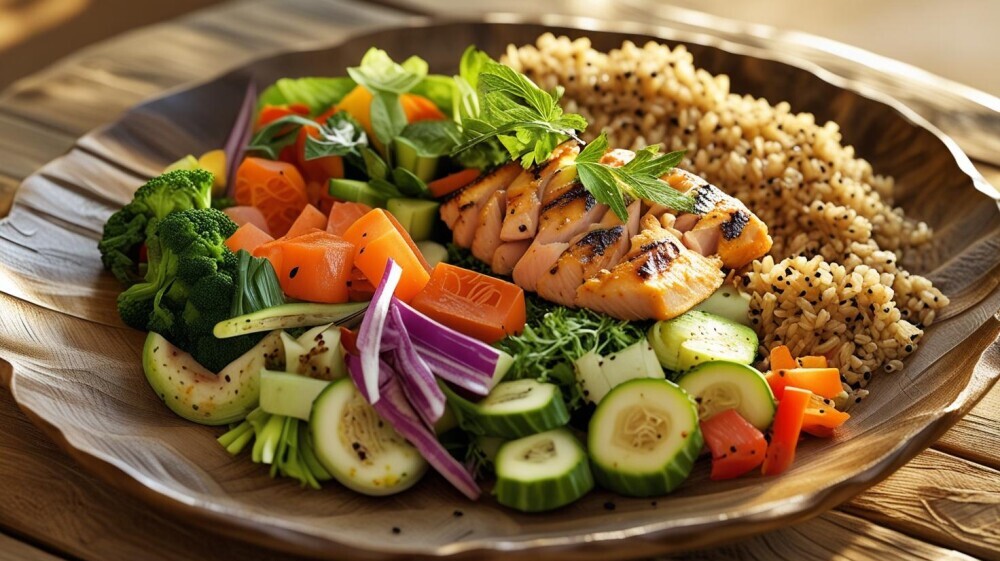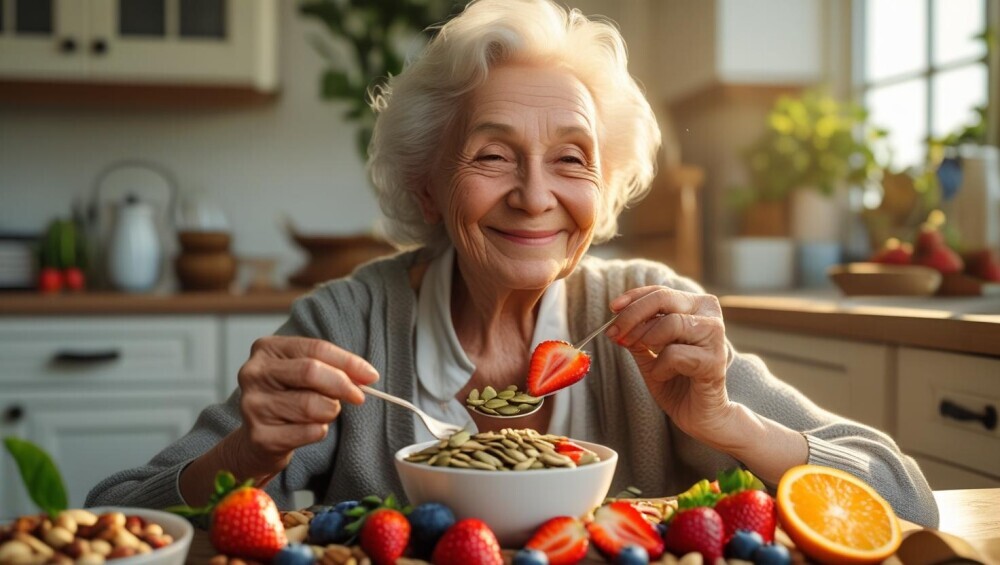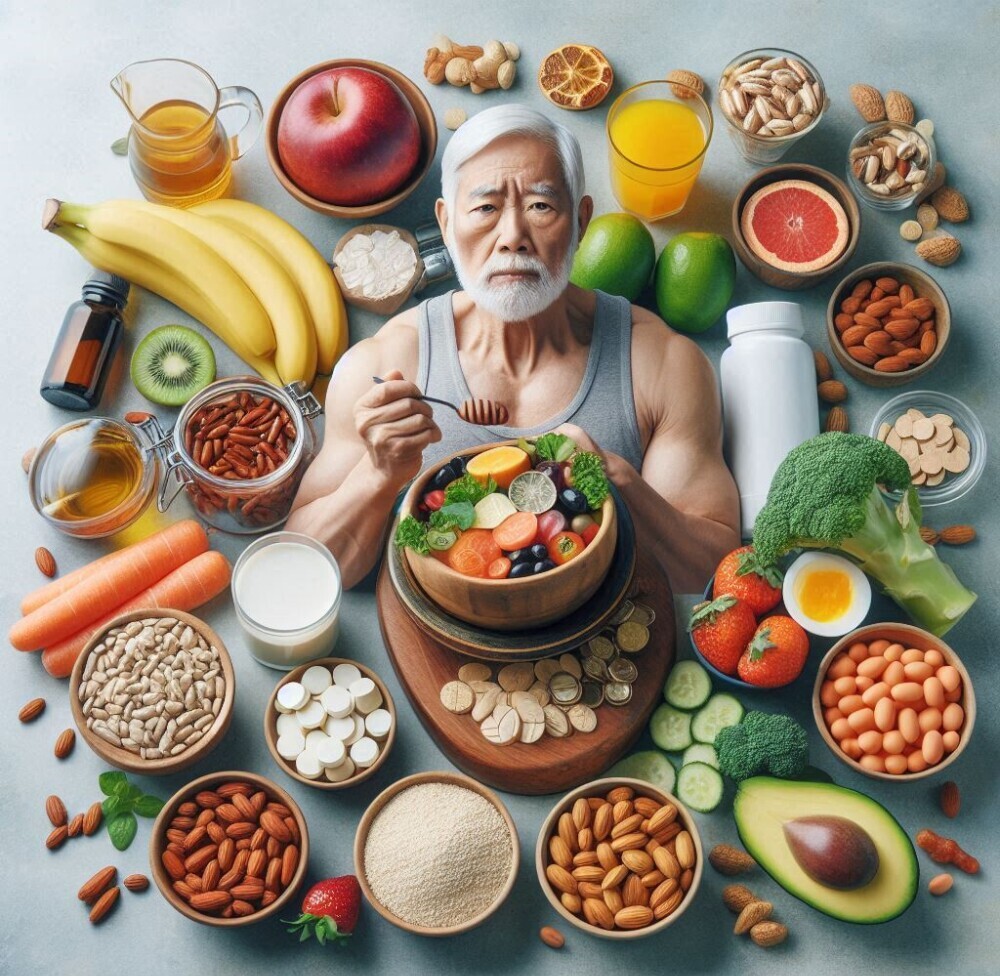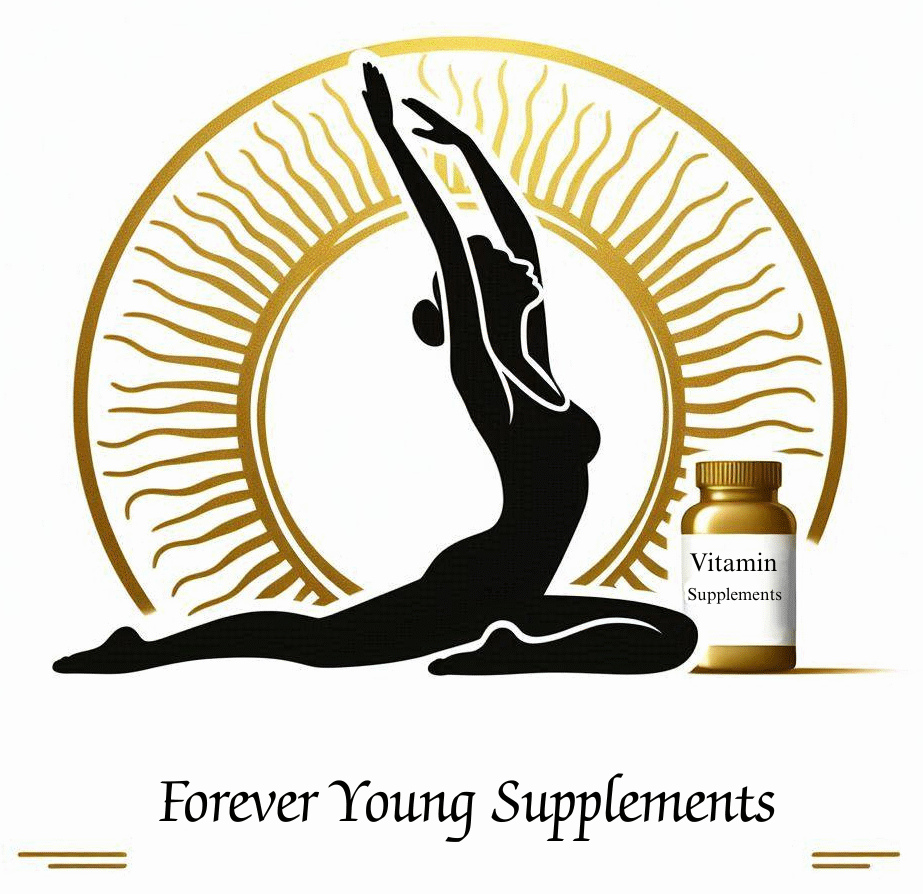Nutrition isn’t just about eating enough, it’s about eating what’s right. As we age, our bodies change, and so do our nutritional needs. It brings physiological changes that impact nutrient absorption, appetite, and overall health. As in shifting the gears on a bike; if you don’t adjust, things might not go as smoothly. Ensuring that our elderly loved ones get the right nutrients is key to keeping them active and healthy.
Several factors influence nutritional needs with age:
- Slower metabolism: Caloric needs drop, but vitamin and mineral needs stay the same or increase.
- Reduced appetite: Eating less can lead to vitamin deficiencies.
- Lower absorption: The stomach may produce less acid, reducing absorption of B12, calcium, and iron.
- Medication interactions: Common prescriptions may deplete nutrients like magnesium, potassium, and certain B vitamins.
One way to counter these changes, is to introduce nutrient dense meals designed with purpose and care.

Rather than relying solely on supplements, which may not be well tolerated or properly absorbed, integrating vitamins into natural, whole-food meals can be a more sustainable and enjoyable approach. In this guide, I explore how to add vitamins to meals, how to create a vitamin rich meal plan, and which nutrients are most critical for older adults plus practical ways to include them in everyday cooking. Quite often care givers and family members are faced with giuving support to thir elderly loved ones as they age and become less able to look after themselves.
So, what should be on the radar? Calcium, Vitamin D, Vitamin B12, fibre.
Calcium and Vitamin D play a big role in maintaining strong bones, something that’s non-negotiable as we age. Not enough of these, and we are looking at increased risks of fractures.
Then there’s Vitamin B12. This little guy is crucial for brain health, nerve tissues, and producing red blood cells. Fun fact: many older adults struggle with absorbing Vitamin B12 from food, so it might need a little more attention.
Chasing a balanced plate is a bit like trying to win a game of Tetris, fitting different pieces together to form a solid line. Seniors need plenty of fibre to keep things moving along smoothly.
However, as we grow older, our body’s ability to absorb these nutrients just isn’t what it used to be. This might mean reassessing diets and looking beyond our old favorites to something that’s a bit more nutrient packed. This means re-educating our taste buds to prioritize what’s beneficial over what’s just yummy. Ensuring everything from fruits and vegetables to grains and proteins are all part of this balanced equation can make a huge difference in the long run.
How to Seamlessly Incorporate Vitamins into Daily Meals
Getting more vitamins into everyday meals doesn’t need to be like solving a complex maths puzzle. With a bit of creativity and a few tweaks here and there, you can boost the nutritional value of meals without shaking up the whole routine. It’s about being smart with choices and knowing where to look.
Starting with breakfast, adding a bunch of spinach or kale to scrambled eggs or smoothies is a simple win. These leafy greens are vitamin powerhouses, especially rich in Vitamin K and C. Plus, they’re almost a seamless addition that doesn’t mess with the flavors you love.
For lunch and dinner, we can look at options like fortified whole-grain bread or pasta. They sneak in those extra vitamins, especially B vitamins, which can be crucial for energy. Integrating beans or lentils into stews and soups not only bumps up the fiber but also boosts mineral intake, like iron and magnesium.
Adding vegetables to every meal can’t be overstated. Think of them as the colourful accessories an outfit needs. Whether it’s a side salad or roasted veg, that splash of color isn’t just pretty; it’s packed with nutrients high in vitamins A, C, E, and K. Use red bell peppers, carrots, spinach, berries, and sweet potatoes regularly. A simple side salad or smoothie can pack several vitamins in one go.
Most of what’s needed should ideally come from unprocessed food. It’s all about avoiding over reliance on pills when possible. Just imagine a plate that’s more vibrant with colors than a pack of vitamin bottles.
Lastly, don’t forget about smart snacking. Nuts, seeds, and fresh fruit can be great sources of vitamins and minerals and they are perfect to munch on between meals. They are small but mighty, offering a consistent nutrient supply throughout the day.

Crafting a Comprehensive Meal Plan for Elders
Meal planning for seniors is about juggling nutrition with flavors they enjoy. It’s about pulling together meals they look forward to while making sure each bite counts for better health.
Start with understanding their preferences. Listening here is key and find out what they love, what they dislike, and what they a’e willing to try once in a while. Tailor the meals to include flavors they appreciate while slipping in those much needed nutrients.
Consider breaking up the day into smaller, more frequent meals instead of three big ones. Smaller meals can be easier on the stomach and help them feel more comfortable, avoiding the sluggishness that sometimes follows a heavy meal.
Balance is crucial. Aim for a mix of proteins, carbohydrates, and fats, but ensure each component carries its weight in nutritional value. For instance, swap regular tinned soups for homemade versions rich in assorted vegetables or lean meat.
Bring in variety. Rotate different meal types or themes throughout the week to keep things interesting. Maybe it’s Italian on Mondays with grilled chicken and vegetable pasta and Greek on Wednesdays with a bean loaded salad.
Lastly, flexibility is vital. A plan is a guideline, not a strict schedule. Seniors have days where appetite might not be on their side or unexpected cravings hit. Being adaptable can help keep meal times stress free and enjoyable for everyone involved.
Achieving a Full Spectrum of Vitamins Through Food
Getting all the vitamins through food sounds like a dream, right? It’s easier than it seems with the right combos and knowledge of nutrient-rich foods. Pairings can maximize how your body absorbs those vitamins, making every meal count. It’s about smarter choices rather than drastic ones.
For starters, think about mixing foods that boost each other’s benefits. Iron, for example, is absorbed better with Vitamin C. Adding a splash of lemon juice to spinach greens or snacking on an orange with breakfast cereal can go a long way.
When planning meals, aim for a variety of fruits and vegetables. It’s like choosing a colorful palette of paints. You need different shades to create a complete picture. Each color denotes different nutrients, so the more colorful the plate, the broader the nutrient spectrum. Besides, colorful meals are far more appealing.
Include foods rich in omega 3s like salmon or flaxseeds to support heart health. Omega 3s are a big deal for the elderly, contributing not just to heart health but also keeping joints happy and functional.
Pushing variety also means including whole grains, which are packed with B vitamins and fibre. Don’t forget about dairy or alternatives, fortified with Vitamin D, to keep bones in check.
Lastly, understanding the food label is like unlocking a secret code. Look for whole, unprocessed options with a diverse list of nutrients. This doesn’t just help in ticking off vitamin needs but also powers energy levels and overall wellness.
Identifying Vital Nutrients for the Elderly and Their Benefits
Navigating the nutritional world can feel like flipping through a massive encyclopedia. Among all the entries, focusing on key nutrients helps zoom in on what’s most beneficial for seniors. These powerhouse nutrients keep them lively and help fend off common age related issues.
Calcium and Vitamin D top the list for their bone boosting abilities. They are crucial allies in preventing bone density loss, which could lead to fractures. It’s like giving bones their very own superhero shield. Beyond bones, Vitamin D also supports immune function, proving it’s a real multitasker.
Vitamin B12 steps in next, championing the nervous system and cognitive health. It supports red blood cell production and helps keep fatigue at bay. Many seniors encounter absorption issues, often needing fortified foods or supplements to meet their needs.
Fibre shouldn’t be underestimated, either. It’s the digestive system’s best friend, aiding in regularity and heart health. Whole grains, fruits, and vegetables are fiber all stars, offering a simple route to meeting dietary goals.
Omega 3 fatty acids, found in fish and some plant oils, support heart health and can ease joint pain. A win win for aging bodies. They also contribute positively to cognitive functions, making them a senior’s ally in more ways than one.
Potassium rounds out the list, crucial for maintaining healthy blood pressure levels. Bananas, sweet potatoes, and legumes are excellent sources. Combined, these nutrients form a balanced diet that reinforces physical strength and sharpness, essential components to vibrant aging.
Practical Meal Preparation Tips for Caregivers
Cooking for seniors involves combining creativity with practicality. It’s about tailoring meals to their taste while ensuring they are nutrient dense. This can often require some clever tricks, especially if the goal is to introduce less favored foods into the diet.

One tactic is disguising healthy ingredients in dishes they already enjoy. Maybe they’re not the biggest fan of carrots in which case you can blend them into a creamy soup where the flavors mix seamlessly, or grate them into a favorite pasta sauce.
Time is golden, especially for those caregiving while juggling other responsibilities. Prepping meals ahead of time can save hassle and transform weekday meal times into a breeze. Batch cooking on the weekends can set you up with homemade meals ready to heat and serve.
Introduce new flavors slowly. While it’s great to spice things up, sudden changes can be off-putting. Instead, try offering small additions to enhance a familiar dish. For instance, experiment with different herbs to boost flavor without overpowering it.
Streamline your storage solutions. Clear, labelled containers help track what’s in your fridge or freezer. This reduces waste and makes it easier to know what’s available for quick meal assembly.
Getting seniors involved in meal prep can be both fun and empowering. Even simple tasks like stirring or washing vegetables can make them feel part of the process, engaged, and more open to trying what’s prepared.
FAQ
1. What are the most important vitamins for the elderly to include in their meals?
Calcium, Vitamin D, Vitamin B12, fiber, and Omega-3 fatty acids are among the most important nutrients for seniors. These support bone health, brain function, digestion, and cardiovascular health.
2. How can I naturally add more vitamins into daily meals for seniors?
Incorporate leafy greens into eggs or smoothies, use fortified whole grains, add beans to soups, and focus on colorful fruits and vegetables. Snack on nuts, seeds, and fresh fruit to maintain a steady nutrient intake throughout the day.
3. Should seniors rely on vitamin supplements or focus on food sources?
Whenever possible, vitamins should come from natural food sources. Whole, unprocessed foods provide better nutrient absorption and additional health benefits. Supplements may be used when deficiencies are present, especially for nutrients like Vitamin B12.

